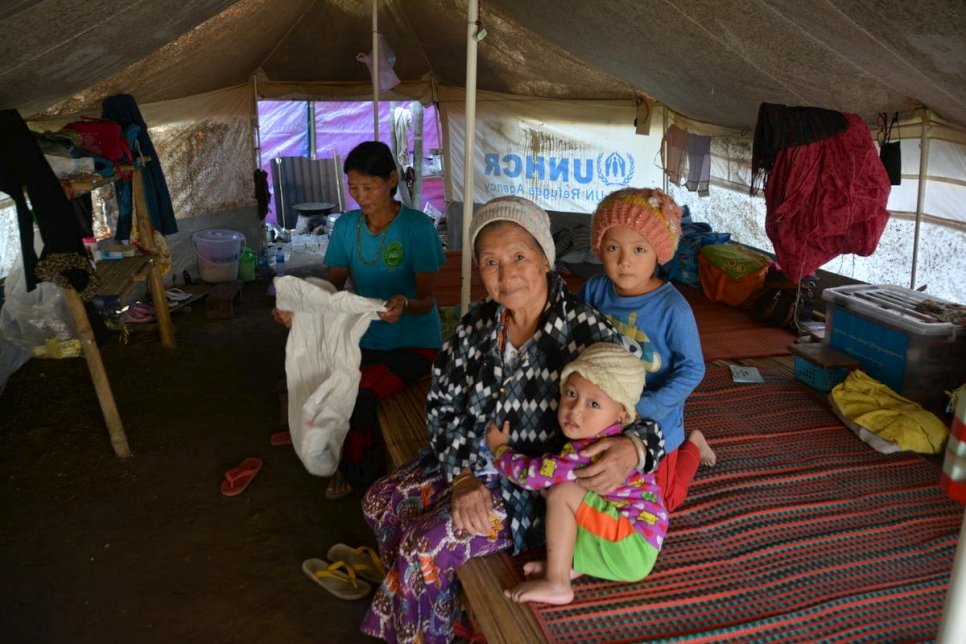UNHCR concerned at mounting civilian casualties and displacement in western Myanmar
This is a summary of what was said by UNHCR spokesperson Andrej Mahecic – to whom quoted text may be attributed – at today's press briefing at the Palais des Nations in Geneva.

Ethnic Rawang villager Ah Ning, 70, looks after her grandchildren in a tent at Ka Bu Dam camp Myitkyina, Kachin State, Myanmar. Ning is displaced and lives in the tent, provided by UNHCR, the UN Refugee Agency. © UNHCR/Paul Vrieze
UNHCR, the UN Refugee Agency, is concerned at reports of mounting civilian casualties and growing displacement triggered by the latest escalation of clashes in western Myanmar.
According to recent local reports, at least 21 civilians have lost their lives as a series of clashes hit their villages along the border between Myanmar’s Rakhine and Chin states earlier this month. Losses among the civilian population have become frequent, and underscore the human cost and heavy impact of a ceaseless conflict on the local communities.
Fighting between the Myanmar Armed Forces and the Arakan Army has continued since a rise in tensions in late 2018. A sharp upward trend in civilian casualties has been observed since February of this year.
UNHCR reiterates its calls to all sides to the conflict in western Myanmar to protect civilians and civilian infrastructure. We are adding our voice to this week’s appeal by the UN Secretary-General António Guterres urging warring parties across the world to cease their fighting in support of the bigger battle against the threat of the COVID-19 pandemic. Civilians in areas ravaged by conflict, in particular those who are displaced, are especially vulnerable in this global public health emergency.
Myanmar authorities estimate that more than 61,000 people are newly displaced in Rakhine State as of 16 March, representing an increase of some 10,000 people as compared to the previous month. They are sheltered across 133 sites. Another 4,800 people are displaced in Chin State in 34 sites.
The latest displacement comes on top of more than 130,000 already displaced people in Rakhine State, most of whom are Rohingya, who have been displaced since 2012. The number of people affected by the conflict is likely to be significantly higher as population movements continue and there are frequent reports of new arrivals at some displacement sites.
Families forced to flee have sought shelter when possible in neighbouring villages and communities. They are mainly taking refuge in religious buildings, schools, and with host families. In remote areas, people affected by the clashes are making shelters of bamboo and tarpaulin in paddy fields.
Speaking to visiting UNHCR teams, displaced families shared their worries – their critical needs include food, shelter, water, sanitation and hygiene. They are also concerned about a lack of access to essential services such as healthcare and education for their children. Breadwinners have been cut off from their livelihoods and affected families are becoming increasingly dependent on humanitarian assistance.
Their return is hindered by ongoing fighting. Newly laid antipersonnel mines and improvised explosive devices pose additional risks. There is also a critical lack of fresh and reliable information as an internet blackout remains in place in nine townships in Rakhine State.
In response to the urgent needs, UNHCR and partners, together with local authorities and humanitarian actors, have provided emergency assistance and protection support to close to 57,000 displaced people as well as host communities since April 2019 across Rakhine and southern Chin states. Assistance includes shelter materials such as tarpaulins, as well as core relief items such as clothes, solar lanterns, blankets, sleeping mats and kitchen items.
Across Myanmar, more than 312,000 people are displaced – mostly in Rakhine, Kachin, and northern Shan states, as well as the South East region.
For more information on this topic, please contact:
- In Myanmar, Aoife Mc Donnell, [email protected], +959 403 487572
- In Bangkok, Catherine Stubberfield, [email protected], +66 65 929 8062
- In Geneva, Andrej Mahecic, [email protected], +41 79 642 97 09
